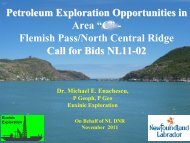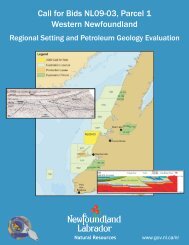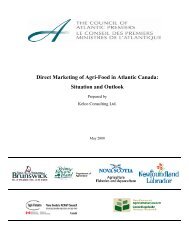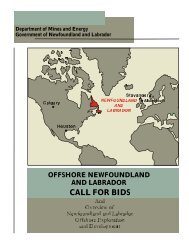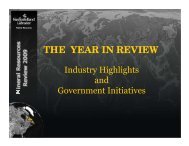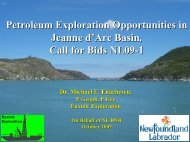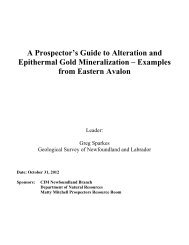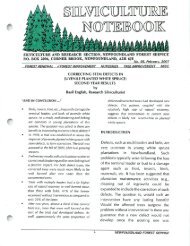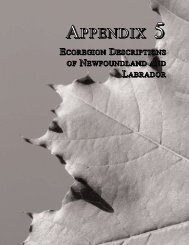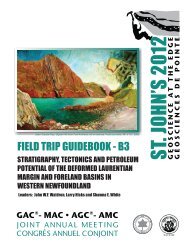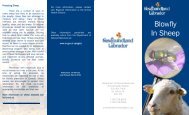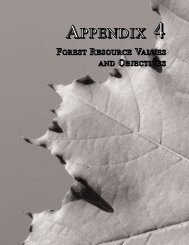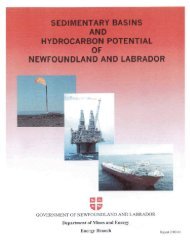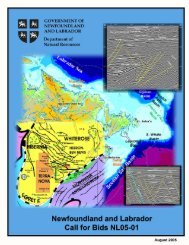Rare Earth Elements - Department of Natural Resources
Rare Earth Elements - Department of Natural Resources
Rare Earth Elements - Department of Natural Resources
You also want an ePaper? Increase the reach of your titles
YUMPU automatically turns print PDFs into web optimized ePapers that Google loves.
Mineral Commodities <strong>of</strong><br />
Newfoundland and Labrador<br />
<strong>Rare</strong>-<strong>Earth</strong> <strong>Elements</strong><br />
Foreword<br />
This is the sixth in a series <strong>of</strong> summary publications covering the principal mineral commodities <strong>of</strong> the Province. Its purpose<br />
is to act as a source <strong>of</strong> initial information for explorationists and to provide a bridge to the detailed repository <strong>of</strong><br />
information contained in the maps and reports <strong>of</strong> the provincial and federal geological surveys, as well as in numerous exploration-assessment<br />
reports. The information contained in this series is accessible via the internet at the Geological Survey <strong>of</strong><br />
Newfoundland and Labrador web site http://www.nr.gov.nl.ca/nr/mines/Geoscience/index.html<br />
Other Publications in the Series<br />
Zinc and Lead. (Number 1, revised 2008) Gold (Number 4, revised 2005)<br />
Nickel (Number 2, revised 2008) Uranium (Number 5, 2009)<br />
Copper (Number 3, revised 2007) <strong>Rare</strong>-<strong>Earth</strong> <strong>Elements</strong> (Number 6, 2011)<br />
Additional Sources <strong>of</strong> Information<br />
Further information is available in the publications <strong>of</strong> the geological surveys <strong>of</strong> Newfoundland and Labrador, and Canada.<br />
The Geological Survey <strong>of</strong> Newfoundland and Labrador also holds a considerable inventory <strong>of</strong> exploration-assessment files<br />
available for onsite inspection at its St. John’s headquarters and for download via the <strong>Department</strong> <strong>of</strong> <strong>Natural</strong> <strong>Resources</strong> web<br />
site: http://www.nr.gov.nl.ca/nr/mines/Geoscience/index.html. Descriptions <strong>of</strong> individual mineral occurrences are available<br />
through the provincial Mineral Occurrence Database System (MODS), which is accessible via the <strong>Department</strong> <strong>of</strong> <strong>Natural</strong><br />
<strong>Resources</strong> web site. Up-to-date overviews <strong>of</strong> mining developments and exploration activity targeting rare-earth elements are<br />
available on-line at http://www.nr.gov.nl.ca/nr/mines/Geoscience/index.html<br />
Contact Addresses<br />
Geological Survey <strong>of</strong> Newfoundland and Labrador Geological Survey <strong>of</strong> Canada<br />
<strong>Department</strong> <strong>of</strong> <strong>Natural</strong> <strong>Resources</strong> 601 Booth Street<br />
P.O. Box 8700 Ottawa, ON, Canada<br />
St. John’s, NL, Canada K1A 0E8<br />
A1B 4J6 Tel.: 613.995.4342<br />
Tel.: 709.729.3159 Fax: 613.943.0646<br />
Fax: 709.729.4491 Long distance (Canada and U.S.A.): 1.888.252.4301<br />
http://www.nr.gov.nl.ca/nr/mines/Geoscience/index.html http://www.NRCan.gc.ca/gsc/<br />
NOTE<br />
The purchaser agrees not to provide a digital reproduction or copy <strong>of</strong> this product to a third party. Derivative products<br />
should acknowledge the source <strong>of</strong> the data.<br />
DISCLAIMER<br />
The Geological Survey, a division <strong>of</strong> the <strong>Department</strong> <strong>of</strong> <strong>Natural</strong> <strong>Resources</strong> (the "authors and publishers"), retains the sole<br />
right to the original data and information found in any product produced. The authors and publishers assume no legal liability<br />
or responsibility for any alterations, changes or misrepresentations made by third parties with respect to these products<br />
or the original data. Furthermore, the Geological Survey assumes no liability with respect to digital reproductions or copies<br />
<strong>of</strong> original products or for derivative products made by third parties. Please consult with the Geological Survey in order to<br />
ensure originality and correctness <strong>of</strong> data and/or products.<br />
Compiled by A. Kerr and H. Rafuse, 2011.<br />
Front Cover: Pink eudialyte, Red Wine Intrusive Suite, Red Wine Mountains, Labrador.
Mineral Commodities <strong>of</strong> Newfoundland and Labrador <strong>Rare</strong>-<strong>Earth</strong> <strong>Elements</strong><br />
Introduction<br />
The rare-earth elements (REE) include the 14 natural<br />
lanthanide elements, i.e., lanthanum (La),<br />
cerium (Ce), praesodymium (Pr), neodymium (Nd),<br />
samarium (Sm), europium (Eu), gadolinium (Gd), terbium<br />
(Tb), dysprosium (Dy), holmium (Ho), erbium<br />
(Er), thulium (Tm), ytterbium (Yb) and lutetium (Lu).<br />
The REEs are divided into light REE (La to Sm) and<br />
heavy REE (Gd to Lu). Europium may be included<br />
with either group, but has distinctly different characteristics<br />
from all other REE. Yttrium (Y) is commonly<br />
included with the REE as it is chemically similar to<br />
heavy REE, and scandium (Sc) is also included within<br />
the group. The REE generally occur in common<br />
rocks at concentrations <strong>of</strong> a few parts per million<br />
(ppm), aside from La, Ce and Y, for which concentrations<br />
above 100 ppm are not unusual; the crustal<br />
abundances <strong>of</strong> these elements resemble those <strong>of</strong> base<br />
metals such as Cu and Pb. The REE are commonly<br />
associated with other elements grouped under the<br />
general term ‘rare metals’; these include Zr, Hf, Nb,<br />
Ta, and Be.<br />
The REE and associated metals have long been<br />
used as pigments in glass and ceramics, and their catalytic<br />
properties are important to the petroleum industry.<br />
They are vital in the high-tech manufacturing sector,<br />
where they are used in high-strength magnets,<br />
flat-screen TVs, lasers, miniature batteries, supercon-<br />
ductors, energy-efficient lighting,<br />
and nanotechnology<br />
applications. Some REE are<br />
important in ‘green revolution’<br />
products, e.g., wind<br />
turbines contain large<br />
amounts <strong>of</strong> neodymium or<br />
dysprosium in lightweight<br />
magnets, as do hybrid gas–electric<br />
vehicles. The amounts <strong>of</strong> these metals consumed<br />
have risen sharply, and demand has increased dramatically<br />
since 2000. However, the markets for REE and<br />
associated metals are small compared to those for<br />
base-metals.<br />
The supplies and markets for REE and associated<br />
elements have also changed significantly since the<br />
early 1980s. China became an important global supplier<br />
in the 1990s, and now accounts for about 95% <strong>of</strong><br />
global production. <strong>Rare</strong>-earth element supplies from<br />
China were limited by the imposition <strong>of</strong> export controls<br />
in 2008; this development, coupled with<br />
increased demand, led to significant commodity price<br />
increases, and exploration interest in deposits outside<br />
China.<br />
The economic forecasts for REE and associated<br />
metals are varied, but some sources predict annual<br />
demand growth rates <strong>of</strong> 8 to 11% between 2010 and<br />
2020. The heavy REE are <strong>of</strong> particular interest, and<br />
are considered strategic by many countries due to lack<br />
<strong>of</strong> substitutes in specialized technology applications.<br />
Deposits <strong>of</strong> REE and associated metals are widely<br />
distributed, and significant undeveloped deposits<br />
exist in Saudi Arabia, Russia, Greenland, Australia<br />
and Canada; one <strong>of</strong> the two largest Canadian examples<br />
is located in Labrador, at Strange Lake.<br />
Historical Review<br />
“<strong>Rare</strong> earth elements are<br />
increasingly important in hightechnology<br />
applications and in the<br />
quest for ‘green energy’. They are<br />
indispensable to the modern world”<br />
1<br />
Over 50 years ago, Be- and Zr-bearing minerals<br />
were first discovered in Labrador by Leslie<br />
Mann, John Michelin and Joe Brummer. These<br />
deposits received limited evaluation in the 1960s, but<br />
saw little systematic work until 2009. In 1979, the<br />
Strange Lake deposit was discovered by the Iron Ore<br />
Company <strong>of</strong> Canada. This Zr–Nb–Y–REE deposit is<br />
one <strong>of</strong> the largest <strong>of</strong> its kind in the world. Several<br />
mining and processing options were investigated, but<br />
development proved difficult due to the remote location,<br />
metallurgical challenges and poor market conditions.<br />
At the time, Zr, Y and Nb were the main commodities<br />
<strong>of</strong> interest, and the REE held little value.<br />
Strange Lake became Exempt<br />
Mineral Land (EML) in<br />
1998, and has remained so.<br />
Exploration resumed in<br />
adjacent Québec in 2008,<br />
and another deposit <strong>of</strong> similar<br />
type has now been<br />
defined west <strong>of</strong> the border.<br />
Recent geophysical and geochemical<br />
surveys in Labrador and Québec have<br />
revealed magnetic features and geochemical anomalies<br />
suggesting the presence <strong>of</strong> several other potentially<br />
fertile igneous complexes. REE–Zr–Y–Nb mineralization<br />
is also known in Newfoundland, notably in<br />
the Fortune Bay area, where it was discovered in the<br />
1980s. Felsic igneous rocks with ‘peralkaline’ compositions,<br />
considered favourable for this style <strong>of</strong> mineralization,<br />
are widespread on the island, but remain<br />
unexplored. The mineral beryl (Be 3Al 2Si 6O 18) occurs<br />
in pegmatites in several areas <strong>of</strong> Newfoundland;<br />
although beryl is commonly more important as a gemstone<br />
than as a source <strong>of</strong> beryllium, these occurrences<br />
are also summarized in this report.
Mineral Commodities <strong>of</strong> Newfoundland and Labrador <strong>Rare</strong>-<strong>Earth</strong> <strong>Elements</strong><br />
Geological Attributes <strong>of</strong><br />
<strong>Rare</strong>-earth Element and<br />
<strong>Rare</strong>-metal Deposits<br />
There are several types <strong>of</strong> primary<br />
REE and rare-metal deposits, and a<br />
wide range <strong>of</strong> secondary deposits derived<br />
by erosion and/or weathering <strong>of</strong> primary<br />
sources. The most important types in<br />
terms <strong>of</strong> resources are associated with<br />
carbonatites and peralkaline igneous<br />
suites. With the exception <strong>of</strong> beryl-bearing<br />
pegmatites, all occurrences in the<br />
province belong to the second group.<br />
Peralkaline igneous rocks are defined by<br />
high contents <strong>of</strong> alkali elements relative<br />
to alumina, such that molecular<br />
(Na2O+K2O) exceeds molecular Al2O3. Under such circumstances, Na-rich mafic<br />
amphiboles and pyroxenes (e.g.,<br />
aegirine, arfvedsonite and reibeckite)<br />
become the dominant mafic minerals,<br />
rather than common Fe–Mg silicates. In<br />
silica-deficient (undersaturated) peralkaline<br />
rocks <strong>of</strong> mafic composition, common<br />
feldspars may be replaced or augmented<br />
by ‘feldspathoid’ minerals such<br />
as nepheline, sodalite, leucite or cancrinite.<br />
Peralkaline magmas favour the concentration<br />
<strong>of</strong> REE and associated elements<br />
by fractionation. Mineralization is<br />
associated with both silica-saturated and<br />
undersaturated peralkaline suites, and the<br />
geometry and associations <strong>of</strong> individual<br />
deposits vary widely. The high concentrations<br />
<strong>of</strong> these elements in residual peralkaline<br />
magmas leads to the formation<br />
<strong>of</strong> a wide range <strong>of</strong> uncommon silicate<br />
and oxide minerals (Table 1), and individual<br />
deposits tend to be mineralogically<br />
unique.<br />
<strong>Rare</strong>-earth elements and rare-metal<br />
deposits in peralkaline suites define two<br />
end-member-types that are respectively dominated by<br />
magmatic and metasomatic–hydrothermal processes,<br />
but many deposits exhibit evidence for both processes.<br />
In magmatic examples, the ore minerals are dis-<br />
persed as essential components<br />
<strong>of</strong> igneous rocks, notably in<br />
pegmatites and aplites, and<br />
hydrothermal alteration is<br />
limited. The host rocks may<br />
be either <strong>of</strong> plutonic or vol-<br />
Table 1. Examples <strong>of</strong> unusual minerals that occur in rare-metal<br />
deposits, and their generalized chemical formulae. Modified after<br />
Richardson and Birkett (1996). Minerals indicated in red are present in<br />
Strange Lake<br />
Mineral name Formula<br />
Silicates<br />
allanite-(Ce) (Ce,Ca) 2(Al, Fe 3+ ) 3(SiO 4) 3(OH)<br />
aenigmatite Na2Fe2+ 5TiSi6O20 armstrongite CaZrSi6O15·3H2O astrophyllite (K,Na) 3Fe2+ 7Ti(Si8O24)(O,OH,F) 7<br />
barylite BaBe2Si2O7 catapleiite CaZrSi3092 H2O dalyite K2ZrSi6O15 elpidite Na2ZrSi6O15·3H2O eucolite (Ca,Na,Ce) 5(Fe2+ , Mn,Y)ZrSi8O22(OH,Cl) 2<br />
eudialyte Na4(Ca,Ce) 2(Fe2+ , Mn,Y)ZrSi8O22(OH,Cl) 2<br />
eudidymite NaBeSi3O7(OH) gadolinite (Ca-rich) Be2(Ca,REE,Fe) 3Si2O10 gittinsite CaZrSi2O7 kainosite Ca2(Y,Ce) 2Si4O12(CO3)·H2O leifite Na2(Si,Al,Be) 7(O,OH,F) 14<br />
milarite K2Ca4Al2Be4Si24O60·H2O mosandrite (rinkite) (Na,Ca,Ce) 3Ti(SiO4) 2F<br />
narsarsukite Na2(TiFe3+ )Si4(O,F) 11<br />
niobophyllite (K,Na) 3(Fe2+ , Mn) 6(NbTi) 2Si8(O,OH,F) 31<br />
thorite (Th,Fe,Y,P,Ca)SiO4 titanite CaTiSiO5 vlasovite Na2ZrSi4O11 zircon ZrSiO4 Oxides<br />
baddelyite ZrO2 betafite (Ca,U) 2(Ti,Nb,Ta) 2O6(OH) fergusonite YNbO4 perovskite (Ca,Na,Fe2+ ,Ce,Sr)(Ti,Nb)O3 pyrochlore (Na,Ca) 2Nb2O6(OH,F) uraninite<br />
Carbonates/fluorides<br />
UO2 bastnaesite-(Ce) (Ca,La)(CO3)F gagarinite-(Y) NaCaY(F,Cl) 6<br />
Phosphates<br />
britholite (Ca,Ce,Y) 5(SiO 4,PO 4) 3(OH,F)<br />
monazite-(Ce) (La,Ce,Nd,Th)PO 4<br />
xenotime YPO 4<br />
“The economic forecasts for<br />
REE and rare-metals are varied, but<br />
some predict annual demand growth<br />
rates <strong>of</strong> 8 to 11% to 2020”<br />
2<br />
canic origin, although the former are more common.<br />
In metasomatic–hydrothermal examples, mineralization<br />
is superimposed on pre-existing rock units<br />
(which may be <strong>of</strong> peralkaline affinity) reflecting the<br />
transfer <strong>of</strong> metals in magmatic<br />
hydrothermal fluids to form<br />
replacement zones or vein<br />
systems. In such deposits,<br />
hydrothermal alteration is<br />
more widespread. Both
Mineral Commodities <strong>of</strong> Newfoundland and Labrador <strong>Rare</strong>-<strong>Earth</strong> <strong>Elements</strong><br />
processes operate together and a complex continuum<br />
<strong>of</strong> mineralization styles may occur. However, the REE<br />
and related metals are all incompatible trace elements<br />
that are concentrated by magmatic fractionation in<br />
peralkaline magmas, and this process appears to be<br />
fundamental to deposit genesis.<br />
<strong>Rare</strong>-earth elements and rare-metal deposits may<br />
include a wide variety <strong>of</strong> uncommon minerals in addition<br />
to better-known minerals such as zircon, allanite,<br />
titanite, monazite and xenotime. Table 1 lists the<br />
names and formulae <strong>of</strong> some <strong>of</strong> these minerals. The<br />
mineralogy <strong>of</strong> these deposits is a critical factor in their<br />
economic evaluation, as some REE-bearing minerals<br />
are highly resistant to<br />
chemical solvent extraction<br />
processes. In many<br />
cases, custom-process<br />
design is required to<br />
successfully extract the<br />
desired commodities<br />
from ore, and from each<br />
other.<br />
In contrast, berylbearing<br />
granitic pegmatites<br />
are associated<br />
with magmatic suites <strong>of</strong><br />
peraluminous affinity<br />
(i.e., those in which alumina<br />
remains following<br />
crystallization <strong>of</strong> feldspars).<br />
Examples in<br />
Newfoundland are associated<br />
with peraluminous<br />
granites, likely<br />
derived by partial melting<br />
<strong>of</strong> metasedimentary<br />
rocks during high-grade<br />
metamorphism.<br />
Mineralization<br />
in Labrador<br />
<strong>Rare</strong>-earth element<br />
and rare-metal mineralization<br />
in Labrador<br />
(Figure 1) is associated<br />
with ‘anorogenic’ highlevel<br />
intrusions <strong>of</strong> peralkaline<br />
felsic rocks and<br />
their extrusive equivalents.<br />
The host rocks<br />
to mineralization are<br />
3<br />
Mesoproterozoic, ranging from ~ 1330 Ma (Letitia<br />
Lake and Red Wine Mountains areas) to ~ 1270 Ma<br />
(Flowers River) to ~ 1240 Ma (Strange Lake). These<br />
peralkaline igneous suites developed in the terminal<br />
stages <strong>of</strong> a major magmatic event, which led to the<br />
emplacement <strong>of</strong> large Mesoproterozoic anorthosite–<br />
granite batholiths across Labrador (Figures 1 and 2).<br />
The Letitia Lake and Red Wine Mountains areas were<br />
subsequently affected by ca. 1000 Ma deformation<br />
and metamorphism. Most examples are considered to<br />
fall broadly into the magmatic end-member type,<br />
although metasomatic–hydrothermal mineralization<br />
may be important at Letitia Lake.<br />
Figure 1. Simplified geological map <strong>of</strong> Labrador, showing the locations <strong>of</strong> selected raremetal<br />
occurrences.
Mineral Commodities <strong>of</strong> Newfoundland and Labrador <strong>Rare</strong>-<strong>Earth</strong> <strong>Elements</strong><br />
�������������<br />
������������<br />
��������������<br />
Strange Lake Deposit<br />
�����������������������<br />
���������������<br />
�<br />
����������������������<br />
����������������<br />
�����������<br />
����������<br />
This deposit is one <strong>of</strong> the largest undeveloped REE<br />
and rare-metal deposits in the world (Figures 3<br />
and 4). The resource was estimated in 1983 at ~57<br />
million tonnes at 2.93% ZrO2, 0.38% Y2O3, 0.08%<br />
BeO, 0.31% Nb2O5, and 0.54% total REE oxides. The<br />
deposit is located northwest <strong>of</strong> Nain (Figure 1) on the<br />
�<br />
�<br />
4<br />
��������������������<br />
���������������<br />
�<br />
����������<br />
�����������������<br />
Figure 2. Schematic diagram illustrating the principal environments <strong>of</strong> formation for rare-metal deposits in<br />
Labrador, and perhaps also Newfoundland; modified after Miller (1989). 1. Disseminated mineralization in undersaturated<br />
peralkaline intrusive rocks; 2. Pegmatite and aplite segregations in the ro<strong>of</strong> zones <strong>of</strong> unvented peralkaline<br />
granites (e.g., Strange Lake); 3 and 4. Pegmatite and aplite veins in vented environments and near-vent extrusive<br />
facies; 5. Disseminated and/or hydrothermal mineralization in permeable peralkaline extrusive facies.<br />
Figure 3. High-grade, fluorite-bearing pegmatite<br />
from the Strange Lake deposit, Zone 1 Lens.<br />
�<br />
Québec–Labrador border; most <strong>of</strong> the high-grade<br />
mineralization and the larger part <strong>of</strong> the resource<br />
defined at that time is located in Labrador.<br />
Mineralization was discovered through follow-up<br />
prospecting <strong>of</strong> surficial U and F anomalies; the<br />
deposit has a well-defined dispersion train including<br />
these elements, Y, REE and Be. Mineralization at<br />
Figure 4. Mineralized aplitic rock from the Strange<br />
Lake deposit, Zone 1 Lens; the red mineral is the<br />
Ca–Zr silicate gittinsite, altered to hematite.
Mineral Commodities <strong>of</strong> Newfoundland and Labrador <strong>Rare</strong>-<strong>Earth</strong> <strong>Elements</strong><br />
Strange Lake is hosted by peralkaline granite that<br />
intrudes gneisses and granitoid rocks <strong>of</strong> the Churchill<br />
Province, and also intrudes an older quartz monzonite<br />
unit. The peralkaline granite has elevated levels <strong>of</strong> U,<br />
Th, Zr, Nb, Y and REE<br />
throughout, but these<br />
are particularly enriched<br />
in a minor phase, which<br />
is located in the centre<br />
<strong>of</strong> the complex (Figure<br />
5). The shape <strong>of</strong> this<br />
‘exotic-rich’ granite is<br />
reminiscent <strong>of</strong> a trumpet-shaped<br />
flower, with<br />
its widest zone close to<br />
the erosion surface.<br />
Near-surface pegmatite<br />
and aplite bodies define<br />
a smaller mass (~ 5 million<br />
tonnes) <strong>of</strong> highgrade<br />
material. The pegmatite<br />
and aplite appear<br />
to be the latest units to<br />
crystallize within the<br />
complex, and veins <strong>of</strong><br />
similar appearance cut<br />
other rock types in the<br />
surrounding area. The<br />
ore zone and associated<br />
rocks include a range <strong>of</strong><br />
uncommon Zr, Y, Be,<br />
Nb and REE-bearing<br />
minerals, such as<br />
elpidite, armstrongite,<br />
gittinsite, pyrochlore,<br />
kainosite and gadolinite,<br />
in addition to more<br />
familiar minerals such<br />
as allanite, thorite, titanite<br />
and zircon (Table 1).<br />
The principal source <strong>of</strong><br />
Zr is gittinsite, and Nb<br />
is hosted largely in<br />
pyrochlore; Y and REE<br />
are hosted within a stillunnamed<br />
Ca–Y silicate,<br />
and several other rare<br />
minerals. Grade estimates<br />
for the Zone 1<br />
Lens vary, but company<br />
documents quote values<br />
<strong>of</strong> 3.25% ZrO 2, 0.66%<br />
Y 2O 3, 0.56% Nb 2O 5,<br />
0.12% BeO and 1.3%<br />
�����������<br />
�<br />
�<br />
��������<br />
�<br />
�<br />
��������<br />
������������<br />
�������<br />
��������������<br />
���������������<br />
�����<br />
�<br />
������<br />
5<br />
�<br />
TREO. The total REE oxide content <strong>of</strong> most samples<br />
was estimated from Y 2O 3 data, but more recent survey<br />
data suggest that about 65% <strong>of</strong> the REE are light and<br />
about 26% are heavy. However, if Y is included with<br />
��������<br />
����<br />
����������<br />
������<br />
�<br />
�<br />
��������������������������<br />
�����������������������������<br />
����������������������<br />
����������<br />
�������������������<br />
��������������<br />
�������������������<br />
���������������<br />
�������������������<br />
������������������<br />
������������<br />
����������������<br />
������������<br />
��������<br />
�����������������<br />
��������������<br />
�����������<br />
�<br />
�<br />
�������������������������������<br />
����������������������<br />
����������������<br />
�����<br />
��������<br />
Figure 5. Geology <strong>of</strong> the Strange Lake (peralkaline) complex and adjacent areas, showing<br />
the location <strong>of</strong> the deposit in a geographically restricted and highly evolved phase <strong>of</strong><br />
the pluton. The terms ’exotic-poor’, ‘exotic’ and ‘exotic-rich’ refer to the abundance <strong>of</strong><br />
unusual minerals containing Zr, Y, Nb, Be and REE. (after Miller, 1990). A. Geological<br />
map <strong>of</strong> the Strange Lake complex, showing deposit location; B. Schematic cross-section<br />
along the line X–Y–Z; C. North–south cross section through the centre <strong>of</strong> the Strange Lake<br />
deposit, showing the high-grade pegmatite and aplite zones that constitute much <strong>of</strong> the<br />
Zone 1 Lens.<br />
��������<br />
����<br />
������<br />
�<br />
�
Mineral Commodities <strong>of</strong> Newfoundland and Labrador <strong>Rare</strong>-<strong>Earth</strong> <strong>Elements</strong><br />
the heavy REE (as is commonly done in exploration),<br />
the heavy REE account for about 55 to 65% <strong>of</strong><br />
TREO* (the asterisk is used to indicate the inclusion<br />
<strong>of</strong> Y with the REE).<br />
The Strange Lake deposit is inferred to have<br />
formed from enriched residual magma and associated<br />
hydrothermal fluids localized in the ro<strong>of</strong> zone <strong>of</strong> the<br />
peralkaline granite, following emplacement <strong>of</strong> the<br />
evolved granite along the contact between two earlier,<br />
less-evolved phases (Figure 5). The enriched magmas<br />
and associated fluids appear to have been trapped in<br />
the ro<strong>of</strong> zone <strong>of</strong> the complex, rather than being dispersed<br />
in a sub-volcanic to volcanic environment<br />
through venting.<br />
Recent exploration in the Strange Lake area has<br />
focused in Québec, notably at Lac Brisson, some 3<br />
km west <strong>of</strong> the border (Figure 5). A new discovery in<br />
this area, termed the ‘Strange Lake B-zone’ consists<br />
<strong>of</strong> sub-horizontal zones <strong>of</strong> highly enriched pegmatite,<br />
which resemble pegmatite–aplite sheets associated<br />
with the Zone 1 Lens in Labrador. A large resource<br />
(almost 100 million tonnes) was announced in 2010,<br />
with grades broadly comparable to those previously<br />
indicated for the main deposit (i.e., approaching 1%<br />
TREO*). The abundances <strong>of</strong> the individual REE<br />
resemble those defined in the main deposit.<br />
Letitia Lake–Red Wine Mountains Area<br />
Beryllium and zirconium were first discovered in<br />
Labrador in the Letitia Lake area (Figure 1), at<br />
the eastern extremity <strong>of</strong> the Central Mineral Belt<br />
(Figure 6). Here, a sequence <strong>of</strong> ca. 1330 Ma peralkaline<br />
volcanic and metavolcanic rocks is intruded by<br />
locally undersaturated peralkaline plutons (syenite to<br />
granite) assigned to the Red Wine Intrusive Suite<br />
(Figure 7). Mineralization occurs in both plutonic and<br />
volcanic settings, but is more common in the former.<br />
This area was affected by the ca. 1000 Ma Grenvillian<br />
Orogeny, and the rocks are metamorphosed and locally<br />
gneissic to mylonitic. Several prospects and showings<br />
are known in the area, and<br />
these fall into two distinct<br />
groups (Figure 8).<br />
Disseminated (magmatic)<br />
mineralization occurs<br />
at several locations in the Red<br />
Wine Mountains, where gneisses <strong>of</strong> nepheline–syenite<br />
composition contain unusual accessory minerals,<br />
<strong>of</strong> which the most common are zircon, eudialyte, bastnaesite,<br />
betafite and perovskite (Table 1). The eudia-<br />
“The Strange Lake deposits<br />
in Labrador and Québec, form one <strong>of</strong><br />
the largest undeveloped rare-metal and<br />
REE resources in the world”<br />
6<br />
Figure 6. Banded mylonitic syenite gneiss hosting<br />
Be–Nb–REE mineralization, Letitia Lake area.<br />
Figure 7. Coarse-grained eudialyte (pink) in<br />
nepheline syenite, Red Wine Mountains area.<br />
lyte contains up to 13.34% ZrO 2 and 2.56% total REE<br />
oxides, and is locally abundant (up to 30% by volume).<br />
Recent exploration work suggests TREO* contents<br />
<strong>of</strong> around 1%, with heavy REE enrichment, and<br />
significant Zr and Y. Unlike most examples <strong>of</strong> REE<br />
mineralization, the eudialyte zones do not contain<br />
radioactive elements such as U and Th. The origin <strong>of</strong><br />
the eudialyte zones is uncertain, but this mineral is<br />
known to be a primary phase in other undersaturated<br />
alkaline complexes such as<br />
Ilimaussaq in southern<br />
Greenland.<br />
Vein-type and disseminated<br />
mineralization is associated<br />
with sub-volcanic quartz<br />
syenites and an adjacent volcanic facies at the Mann<br />
#1, #2 and Two Tom Lake occurrences (Figure 8);<br />
these represent a more complex style <strong>of</strong> deposit, in<br />
which Zr, Nb, Y and REE are accompanied by strong
Mineral Commodities <strong>of</strong> Newfoundland and Labrador <strong>Rare</strong>-<strong>Earth</strong> <strong>Elements</strong><br />
B<br />
Michelin #1<br />
+<br />
+<br />
+<br />
Mann #2<br />
A<br />
Southwest<br />
Ten Mile Lake<br />
Seal Lake Group(˜1240 Ma)<br />
Letitia Lake Group<br />
Sedimentary rocks<br />
Peralkaline volcanic rocks<br />
Quartz-feldspar porphyry<br />
Sedimentary rocks<br />
Replacement<br />
mineralization<br />
Quartz-feldspar porphyry<br />
Mann #1<br />
Letitia Lake<br />
Intrusive Rocks<br />
Red Wine Intrusive Suite<br />
North Pole Brook (˜1240 Ma)<br />
Intrusive Suite (˜1650 Ma)<br />
Basal unconformity<br />
Be enrichment. The main ore mineral at Mann #1 is<br />
barylite, although pyrochlore and niobophyllite are<br />
also locally important; the deposit contains up to<br />
0.24% Nb. Recent exploration work has demonstrated<br />
that all these zones are Be-enriched and that REE<br />
mineralization occurs over significant widths, including<br />
1.35% TREO* over 106 m. Mineralization is<br />
present in tabular zones exceeding 1 km in strike<br />
length, hosted by strongly deformed (locally<br />
mylonitic) peralkaline rocks. The original relationships<br />
are obscured by strong deformation, but crosscutting<br />
REE-enriched veins are documented in areas<br />
<strong>of</strong> lower strain, and it is suspected that mineralization<br />
7<br />
Two Tom Lake<br />
Bessie Lake<br />
REE-Nb-Be<br />
Significant undeveloped deposit<br />
+<br />
+<br />
Peralkaline intrusive rocks Mineralized veins<br />
5 km<br />
Significant occurrence<br />
Minor occurrence<br />
Seal Lake Group<br />
was originally developed<br />
as vein swarms<br />
and related metasomatic<br />
zones. These were later<br />
transposed within a<br />
regional shear zone. A<br />
wide variety <strong>of</strong> REEbearing<br />
silicate minerals<br />
occur, and are listed in<br />
Table 1. Data from<br />
recent exploration suggests<br />
that the REE are<br />
dominated by light<br />
REE, and that La, Ce<br />
and Nd are the most<br />
abundant elements. The<br />
Be and REE occurrences<br />
in the Letitia<br />
Lake area have received<br />
only limited exploration<br />
attention since the<br />
1960s, although potential<br />
host rocks <strong>of</strong> peralkaline<br />
composition are<br />
widespread.<br />
Flowers River<br />
Area<br />
The ~ 1270 Ma<br />
Flowers River<br />
Intrusive Suite (Figure<br />
1) is the largest peralkaline<br />
plutonic complex<br />
known in Labrador, and<br />
extrusive rocks are<br />
locally preserved in a<br />
caldera-like structure.<br />
The volcanic rocks<br />
(known as the Nuiklavik<br />
volcanics) exhibit<br />
strong local Zr and Nb enrichment, notably in ashflow<br />
tuffs. Pegma-tite and pegmatite–aplite dykes<br />
likely associated with nearby high-level peralkaline<br />
granites also locally contain mineralization. The area<br />
has not been extensively explored for REE, although<br />
there has been some recent interest in its uranium<br />
potential. Historical data indicate TREO* contents up<br />
to 1.1%, with appreciable heavy REE components.<br />
Figure 8. A. Simplified geological map <strong>of</strong> the Letitia Lake area in central Labrador, indicating<br />
the locations <strong>of</strong> Be and Zr–Y–Nb–REE occurrences, modified after Miller (1989).<br />
Note that disseminated eudialyte hosted by undersaturated peralkaline rocks and their<br />
metamorphosed equivalents occurs several kilometres south <strong>of</strong> the Southwest Ten Mile<br />
Lake showing. B. Schematic diagram illustrating the inferred settings <strong>of</strong> rare-metal mineralization<br />
in the Letitia Lake area, after Miller (1989).<br />
Letitia Lake Group<br />
Southeastern Labrador<br />
At Fox Harbour (St. Lewis) in southeastern<br />
Labrador, a radioactive ‘mylonitic zone’ sampled
Mineral Commodities <strong>of</strong> Newfoundland and Labrador <strong>Rare</strong>-<strong>Earth</strong> <strong>Elements</strong><br />
during mapping contained up to 3.4% Zr, and anomalous<br />
REE. Subsequent exploration in the area<br />
between Port Hope Simpson (Figure 9) and St. Lewis<br />
has revealed more extensive Zr–Nb–REE mineralization<br />
<strong>of</strong> at least two discrete types. These include banded<br />
gneisses <strong>of</strong> feldspathic composition that host lowgrade<br />
(up to 1.2% TREO*) light REE-enriched mineralization<br />
scattered over wide areas, possibly representing<br />
metavolcanic suites <strong>of</strong> peralkaline composition.<br />
High-grade REE mineralization, with strong<br />
enrichment in heavy REE, is associated with dense<br />
pegmatite swarms in several areas, and may be associated<br />
with younger (post-tectonic) igneous suites.<br />
Recognition <strong>of</strong> these zones has generated significant<br />
exploration interest in other parts <strong>of</strong> the Grenville<br />
Province (Figure 1).<br />
Figure 9. Mineralized pegmatite from the Port Hope<br />
Simpson area, southeast Labrador; yellow-weathering<br />
mineral is believed to be the REE-rich phase.<br />
Other Areas <strong>of</strong> Labrador<br />
In the Popes Hill area near Goose Bay, REE mineralization<br />
<strong>of</strong> uncertain origin has been detected in<br />
metamorphic rocks <strong>of</strong> the Grenville Province; little is<br />
presently known about these occurrences, but they<br />
appear to be light REE-enriched and locally highgrade.<br />
In the remote area along the Québec–Labrador<br />
border region south <strong>of</strong> Strange Lake, geochemically<br />
evolved granites have been detected during recent<br />
exploration and these host REE-enriched mineralization.<br />
Preliminary interpretation suggests that they are<br />
younger intrusive complexes within the ca. 1400 Ma<br />
Mistastin Batholith. Several other minor occurrences<br />
<strong>of</strong> REE and associated rare metals are known across<br />
Labrador, but these have not been described or<br />
explored in detail.<br />
8<br />
Mineralization in Newfoundland<br />
Significant occurrences in Newfoundland (Figures<br />
10 and 11) include showings <strong>of</strong> Zr–Y and REE in<br />
the Fortune Bay area and near Clode Sound, Trinity<br />
Bay; there are also scattered indications <strong>of</strong> beryllium<br />
associated with pegmatites. <strong>Rare</strong>-earth element mineralization<br />
is also reported from the Lost Pond area,<br />
near Stephenville. As in Labrador, the most significant<br />
examples are associated with plutonic and volcanic<br />
rocks <strong>of</strong> peralkaline composition.<br />
Several zones enriched in Zr, Y and REE occur<br />
within the late Ediacaran (~547 Ma) Cross Hills<br />
Plutonic Suite near Fortune Bay (Figure 11). The suite<br />
ranges in composition from alkaline gabbro to peralkaline<br />
granite, but all mineralization is hosted by the<br />
latter. The most significant showings consist <strong>of</strong> disseminated<br />
zircon, baddelyite and fergusonite in aplitic<br />
peralkaline dykes. Grab samples contain up to 2% Zr,<br />
2300 ppm Nb and 1500 ppm Ce, and there is also<br />
enrichment in Sn and Ta. There is little data on the<br />
concentrations <strong>of</strong> other REE in the mineralized samples.<br />
<strong>Rare</strong>-earth mineralization, recently reported at<br />
the Lost Pond showings in western Newfoundland,<br />
includes drill intersections <strong>of</strong> 5.7 m at 4.5% TREO*,<br />
and grab samples containing up to 10% TREO*. The<br />
host rock is believed to be the Hare Hill Granite, a<br />
small peralkaline pluton <strong>of</strong> Ediacaran (~605 Ma) age.<br />
Peralkaline granites <strong>of</strong> the Topsails Intrusive Suite are<br />
reported to contain Zr and REE-enriched outcrops and<br />
boulder fields, with up to 2.3% Zr and 3.1% TREO,<br />
but little is presently known about these occurrences.<br />
Two small occurrences in the Clode Sound area<br />
contain elevated levels <strong>of</strong> Zr (up to 0.25%), Y (up to<br />
300 ppm) and Nb (up to 363 ppm), associated with<br />
Figure 10. Flow-banded peralkaline rhyolite, Kings<br />
Point Complex, central Newfoundland.
Mineral Commodities <strong>of</strong> Newfoundland and Labrador <strong>Rare</strong>-<strong>Earth</strong> <strong>Elements</strong><br />
sulphides. The host<br />
rocks are unidentified,<br />
possibly part <strong>of</strong> the Bull<br />
Arm Formation, a<br />
regionally extensive<br />
unit <strong>of</strong> mafic and felsic<br />
volcanic rocks including<br />
peralkaline compositions.<br />
The Bull Arm<br />
Formation is believed to<br />
be similar in age to the<br />
Cross Hills Plutonic<br />
Suite, and small areas <strong>of</strong><br />
peralkaline granite are<br />
also known in the Clode<br />
Sound area.<br />
Other rare-metal<br />
occurrences consist <strong>of</strong><br />
small amounts <strong>of</strong> beryl<br />
hosted by granites and<br />
granitic pegmatites.<br />
These occur in the<br />
Bonavista North area, in<br />
and around the Middle<br />
Ridge Granite in central<br />
Newfoundland, and in<br />
southwestern Newfoundland<br />
(Figure 11).<br />
Most are associated<br />
with muscovite-bearing<br />
peraluminous granites.<br />
None <strong>of</strong> the beryl occurrences<br />
in Newfoundland<br />
are reported to contain<br />
high-quality transparent<br />
gem material.<br />
Exploration<br />
Potential<br />
The strong association between rare-metal mineralization<br />
and peralkaline igneous suites suggests<br />
that several areas may have potential for future dis-<br />
coveries. In Labrador, Mesoproterozoic<br />
‘anorogenic’ intru-<br />
Figure 11. Simplified geological map <strong>of</strong> Newfoundland showing selected rare-metal<br />
occurrences, and also the locations <strong>of</strong> peralkaline intrusive and volcanic suites that may<br />
have exploration potential for rare metals.<br />
sive suites are widespread,<br />
notably north <strong>of</strong> the<br />
Grenville Province, and<br />
wherever peralkaline compositions<br />
are reported, there are<br />
instances <strong>of</strong> Zr–Y–Be–Nb–REE mineralization. The<br />
present level <strong>of</strong> geological mapping in northern<br />
Labrador is not detailed enough to reveal small peral-<br />
“Peralkaline igneous suites<br />
in Newfoundland have received little<br />
systematic assessment for rare-metals<br />
or REE”<br />
9<br />
kaline plutons such as the Strange Lake complex. In<br />
southern Labrador, there are numerous circular<br />
granitic plutons representing late-stage magmatism in<br />
the Grenville Province, and<br />
many <strong>of</strong> these appear to be<br />
compositionally evolved.<br />
This also represents a potential<br />
environment for peralkaline<br />
rocks and related mineralization.<br />
Recent high-resolution<br />
aeromagnetic surveys completed as part <strong>of</strong> a joint<br />
Federal–Provincial project in the Schefferville–<br />
Smallwood Reservoir area show circular magnetic
Mineral Commodities <strong>of</strong> Newfoundland and Labrador <strong>Rare</strong>-<strong>Earth</strong> <strong>Elements</strong><br />
Figure 12. Examples <strong>of</strong> prominent circular magnetic features in the area <strong>of</strong> the Smallwood Reservoir, near the<br />
Québec–Labrador border, as revealed by recent high-resolution aeromagnetic surveys. These are believed to represent<br />
unexplored intrusive complexes, possibly <strong>of</strong> peralkaline composition. The area is also associated with anomalous<br />
fluorine in lake waters.<br />
features (Figure 12) now known to correspond with<br />
peralkaline ring-complexes associated with REE<br />
enrichment. Similar surveys elsewhere, in poorly<br />
exposed regions <strong>of</strong> Labrador, could easily produce the<br />
same outcome. Assessment and re-analysis <strong>of</strong> lakesediment<br />
geochemical data through the region also<br />
suggests that not all U, F and REE anomalies have<br />
been satisfactorily explained, and ring-like magnetic<br />
anomalies can be revealed by careful analysis <strong>of</strong><br />
regional geophysical data.<br />
On a percentage areal basis, peralkaline igneous<br />
rocks are more abundant in Newfoundland than in<br />
Labrador. The largest examples are the Silurian (~429<br />
10<br />
Ma) Topsails Intrusive Suite and the Devonian (~375<br />
Ma) St. Lawrence Granite, but several other Paleozoic<br />
peralkaline suites occur in central Newfoundland.<br />
Precambrian peralkaline plutons occur in both eastern<br />
and western Newfoundland, where they are associated<br />
with minor rare-metal mineralization. There are<br />
also peralkaline volcanic rocks <strong>of</strong> both Precambrian<br />
and Paleozoic age (Figure 11). Most peralkaline<br />
igneous suites in Newfoundland have never been<br />
explored for rare metals or REE, and the few known<br />
occurrences remain undrilled.<br />
The well-developed glacial dispersion trails from<br />
the Strange Lake deposit (Figure 13) indicate that sur-
Mineral Commodities <strong>of</strong> Newfoundland and Labrador <strong>Rare</strong>-<strong>Earth</strong> <strong>Elements</strong><br />
Figure 13. Perspective aerial view <strong>of</strong> the glacial dispersion trail from the Strange Lake deposit, as shown by the distribution<br />
<strong>of</strong> yttrium (Y) in till samples. The white sample sites represent background values and the red circles indicate<br />
the strongest enrichment in Y.<br />
ficial geochemical methods represent an effective<br />
exploration tool for deposits <strong>of</strong> this type, and lakesediment<br />
data from across Labrador have now been<br />
re-analyzed for selected REE elements. The common<br />
association between rare-metal mineralization and<br />
elevated U and Th concentrations indicates that radiometric<br />
surveys are also effective in discovering such<br />
occurrences. Known rare-metal mineralization in the<br />
province was, in most cases, discovered through the<br />
radioactivity imparted by associated U and Th, and<br />
this remains the most useful prospecting tool, coupled<br />
with lake-sediment geochemical data. The surge in<br />
uranium exploration since 2000 has already led to the<br />
discovery <strong>of</strong> rare-metal mineralization in western<br />
Newfoundland, and it may yet lead to new discoveries<br />
elsewhere. The re-analysis <strong>of</strong> archived lake-sediment<br />
geochemical data, and the acquisition <strong>of</strong> similar<br />
data from till sampling, will be useful in assessing<br />
potential in unexplored areas. The resistant and dense<br />
nature <strong>of</strong> many <strong>of</strong> the unusual REE-bearing minerals<br />
suggests that indicator mineral surveys similar to<br />
those used to explore for diamondiferous kimberlites<br />
may also have utility in this search.<br />
11<br />
Selected References<br />
Batterson, M. J.<br />
1989: Glacial dispersion from the Strange Lake<br />
alkalic complex, northern Labrador. Geological<br />
Survey <strong>of</strong> Canada, Paper 89-20, p. 31-40.<br />
Birkett, T.C., Miller, R. R., and Roberts, A. C.<br />
1992: Zirconium-bearing minerals <strong>of</strong> the Strange<br />
Lake Intrusive Complex, Québec–Labrador.<br />
Canadian Mineralogist, Volume 30, p. 191-205.<br />
Curtis, L. W., and Currie, K. L.<br />
1981: Geology and petrology <strong>of</strong> the Red Wine<br />
alkaline complex, central Labrador. Geological<br />
Survey <strong>of</strong> Canada, Bulletin 294, 61 p.<br />
Gale, G. H.<br />
1967: Economic assessment <strong>of</strong> pegmatites,<br />
Newfoundland. Newfoundland <strong>Department</strong> <strong>of</strong><br />
Mines, Agriculture and <strong>Resources</strong>, unpublished<br />
report (NFLD/0314).
Mineral Commodities <strong>of</strong> Newfoundland and Labrador <strong>Rare</strong>-<strong>Earth</strong> <strong>Elements</strong><br />
Hill, J., and Miller, R. R.<br />
1990: A review <strong>of</strong> Middle Proterozoic epigenic<br />
felsic magmatism in Labrador. Geological<br />
Association <strong>of</strong> Canada, Special Paper 38, p. 417-<br />
431.<br />
Iron Ore Company <strong>of</strong> Canada (IOC)<br />
1985: Preliminary feasibility study and related<br />
documents, Strange Lake Project. Unpublished<br />
Report, Iron Ore Company <strong>of</strong> Canada<br />
[Geological Survey File 024A/08/0029]<br />
Kerr, A.<br />
2011: <strong>Rare</strong> <strong>Earth</strong> Element (REE) mineralization<br />
in Labrador: A review <strong>of</strong> known environments<br />
and the geological context <strong>of</strong> current exploration<br />
activity. In Current Research. Newfoundland and<br />
Labrador <strong>Department</strong> <strong>of</strong> <strong>Natural</strong> <strong>Resources</strong>,<br />
Geological Survey, Report 2011-1, p. 109-145.<br />
Miller, R. R.<br />
1986: Geology <strong>of</strong> the Strange Lake alkalic complex<br />
and associated Zr-Y-Nb-Be-REE mineralization.<br />
In Current Research. Newfoundland<br />
<strong>Department</strong> <strong>of</strong> Mines and Energy, Mineral<br />
Development Division, Report 86-1, p. 11-19.<br />
Miller, R. R.<br />
1988: Yttrium (Y) and other rare metals (Be, Nb,<br />
REE, Ta, Zr) in Labrador. In Current Research<br />
Newfoundland <strong>Department</strong> <strong>of</strong> Mines and Energy,<br />
Mineral Development Division, Report 88-1, p.<br />
229-245.<br />
Miller, R. R.<br />
1989: <strong>Rare</strong>-metal targets in insular<br />
Newfoundland. In Current Research,<br />
Newfoundland <strong>Department</strong> <strong>of</strong> Mines and Energy,<br />
Geological Survey Branch, Report 89-1, p. 171-<br />
179.<br />
12<br />
Miller, R. R.<br />
1990: The Strange Lake pegmatite-aplite hosted<br />
rare metal deposit, Labrador. In Current<br />
Research, Newfoundland <strong>Department</strong> <strong>of</strong> Mines<br />
and Energy, Geological Survey Branch, Report<br />
90-1, p. 171-182.<br />
Miller, R. R., Heaman, L. M., and Birkett, T. C.<br />
1997: U-Pb zircon age <strong>of</strong> the Strange Lake peralkaline<br />
complex: implications for Meso-proterozoic<br />
peralkaline magmatism in north-central<br />
Labrador. Precambrian Research, Volume 81, p.<br />
67-82.<br />
Richardson, D. G., and Birkett, T. C.<br />
1996: Peralkaline rock-associated rare metals. In,<br />
Geology <strong>of</strong> Canadian Mineral Deposit types.<br />
Geological Survey <strong>of</strong> Canada, Geology <strong>of</strong><br />
Canada, Volume 8, p. 523-540.<br />
Salvi, S., and Williams-Jones, A. E.<br />
1990: The role <strong>of</strong> hydrothermal processes in the<br />
granite-hosted Zr-Y-REE deposit at Strange<br />
Lake, Québec-Labrador. Geochimica<br />
Cosmochimica Acta, Volume 54, p. 2403-2418.<br />
Saunders, C. M., and Tuach, J.<br />
1989: Zr-Y-Nb-REE mineralization in the Cross<br />
Hills Plutonic Suite. In Current Research.<br />
Newfoundland <strong>Department</strong> <strong>of</strong> Mines and Energy,<br />
Geological Survey Branch, Report 89-1, p. 181-<br />
192.<br />
Tuach, J.<br />
1991: The geology and geochemistry <strong>of</strong> the Cross<br />
Hills Plutonic Suite, Fortune Bay,<br />
Newfoundland. Newfoundland <strong>Department</strong> <strong>of</strong><br />
Mines and Energy, Geological Survey Branch,<br />
Report 91-2, 73 p.



